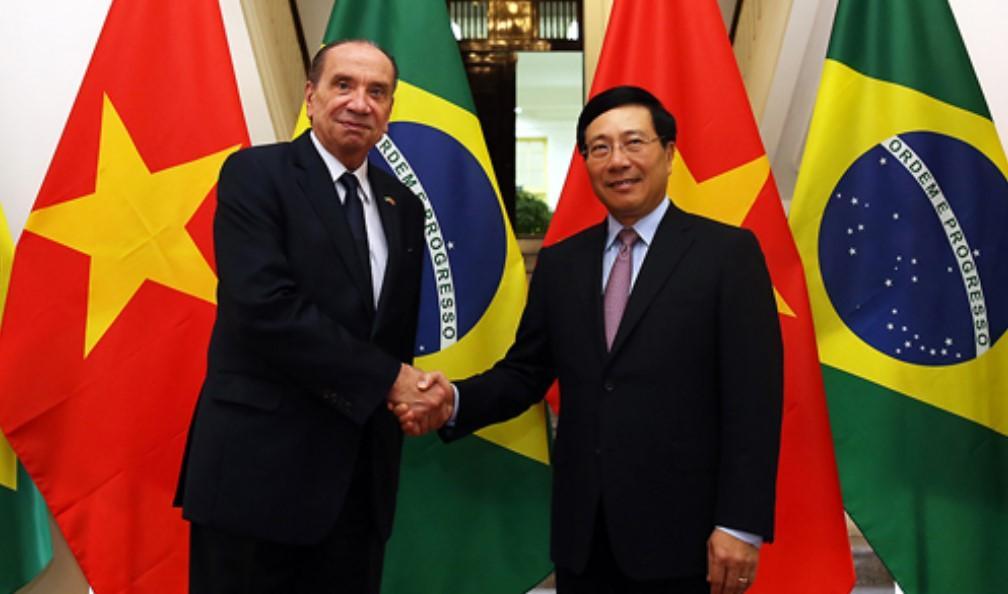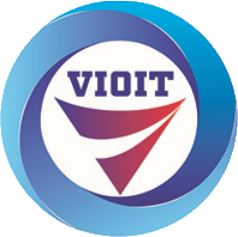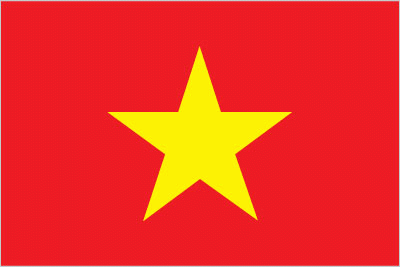
Solutions to promoting the bilateral trade relation between Vietnam and Brazil in a new international context
10:09 - 22/09/2021
M.A. Le Hong Quang,
Ministry of Industry and Trade
During the past years, Vietnam and Brazil have witnessed and enjoyed great developments in the bilateral relationship. The two countries jointly established their diplomatic relation in 1989. Brazil had set up its Embassy in Hanoi since 1994, then six years later, Vietnam built Embassy, upgraded from a General Consulate (Sao Paulo) in 2000. Vietnam and Brazil declared a bilateral comprehensive partnership in 2007. Regarding the trade relation, Brazil has been the top trading partner of Vietnam in Latin America and the second partner in the whole Americas after the US. Despite the Pandemic of Covid-19, the trade value between the two countries has reached USD 4.6 billion, increased by 23.3% in comparison with that of 2019. However, the bilateral trade development is still below the expectation and competitiveness advantage of each country. This proves the need for breakthrough solutions in the coming time.
Keywords: Brazil; Export; Import; Market; Trade relation.
- Overview of the Brazilian market
Brazil is located in the Southeastern part of the South American continent with a land area of 8.5 million km2. Brazil concludes the main part of the very nutrient Amazon River basin. To the east, Brazil connects with the Atlantic Ocean which provides it with a long coastal line and a system of the most modern deep seaports in South America that support very well international transactions.
Brazil now has a population of about 210 million people, the 6th most populated country in the world. The population structure of Brazil is composed of young generations with an average age of 34 years of which 85% are living in urban areas. This makes Brazil a big consumer market with a strong and wide spectrum of consumption.
In terms of politics, Brazil is a federative republic of 26 states and a capital region (Brazilia), its government structure is quite similar to that of the US. Brazil is a multi-ethnic nation. The peoples are from all over the world but mainly from Europe, Africa, Lebanon, Japan, Korea, and China. Brazil is also the biggest Catholic country with 80% of its citizens being Christians.
The nominal Gross Domestic Production (GDP) of Brazil has reached around USD 1.800 billion, the 9th biggest economy in the world, GDP per capita is about USD 8.500 per annum. Brazilian GDP structure is comprised of the service sector with 75%, the industry with 19%, and agriculture with purely 6% but agricultural export represents up to 30% of the total export of Brazil annually. Main industries are chemical, footwear, textile, minerals, machinery, and parts, while agricultural products are mainly such as cattle and poultry meats (leader in the international market), corn, soybean, coffee, pepper, Brazilian nuts, cotton (all ranking first or very high in the market). In addition, Brazil has a very good infrastructure system, abundant resources to support more development in the agriculture business.
The openness of the Brazilian economy is quite moderate, and it focuses more on the intra-trade of Mercosur (the common market of South America). In 2020, the international trade value of Brazil was just only USD 375 billion, of which, export turnover was USD 209 billion, and import value was USD 166 billion. The ratio of international trade per GDP was merely 25%.
- The Brazilian export
Brazil has a strong advantage of exporting commodities, materials, minerals, machinery, vehicles… Agriculture is a stronghold of Brazilian exportation. In 2020, the main export markets of Brazil are China (1%), the US (16%), Germany (5%), Argentina (5%), Korea (2%).
Table 1: The main exports of Brazil in 2016-2020
Unit: USD bil
No | Description (HS.Rev3) | 2016 | 2017 | 2018 | 2019 | 2020 | Av growth |
| Total export value | 179.53 | 214.99 | 231.89 | 221.13 | 209.18 | 3.90 |
1 | Oilseeds and oil-fruits | 19.56 | 26.01 | 33.38 | 26.42 | 29.04 | 10.39 |
2 | Ores and their by-products | 15.82 | 22.40 | 23.67 | 25.84 | 28.89 | 16.26 |
3 | Fuels | 11.58 | 18.72 | 29.61 | 30.31 | 24.87 | 21.06 |
4 | Meat and meat products | 12.66 | 13.95 | 13.28 | 15.30 | 15.82 | 5.74 |
5 | Sugar and confectionery | 10.58 | 11.57 | 6.67 | 5.34 | 8.89 | -4.28 |
6 | Iron and steel | 7.89 | 10.76 | 11.78 | 10.95 | 8.67 | 2.39 |
7 | Boiler and Machinery | 11.02 | 13.23 | 14.33 | 12.20 | 8.34 | -6.73 |
8 | Transport vehicles | 10.97 | 14.72 | 12.61 | 9.22 | 6.79 | -11.31 |
9 | Cereals | 4.11 | 4.98 | 4.50 | 7.78 | 6.47 | 12.03 |
10 | Wastes of the food industry | 5.54 | 5.39 | 7.10 | 6.33 | 6.45 | 3.89 |
Source: UN Comtrade 2020
- The Brazilian imports
The main imported goods into the Brazilian economy are products for supporting industries, re-processing for export, and other production inputs. The principal exporters are China (31%), the US (14%), Argentina (5%), Holland (5%), Mexico (3%), Vietnam is the number 17th largest exporter into the Brazilian market.
Table 2: the main imported products of Brazil in 2016-2020
Unit: USD bil
No | Description (HS.Rev3) | 2016 | 2017 | 2018 | 2019 | 2020 | Av growth |
| Total import value | 145.25 | 165.86 | 192.84 | 193.16 | 166.34 | 3.45 |
1 | Boilers and machinery | 21.83 | 21.85 | 24.82 | 27.00 | 24.41 | 2.84 |
2 | Electronics | 17.50 | 22.10 | 23.45 | 24.02 | 22.54 | 6.52 |
3 | Mineral fuels | 17.94 | 24.37 | 29.13 | 26.77 | 16.74 | -1.71 |
4 | Chemicals | 8.59 | 8.74 | 10.98 | 11.30 | 10.81 | 5.91 |
5 | Vehicles | 10.26 | 12.20 | 15.57 | 14.89 | 10.08 | -0.45 |
6 | fertilizers | 6.42 | 7.90 | 9.30 | 9.85 | 8.71 | 7.91 |
7 | Pharmaceuticals | 6.55 | 6.73 | 7.44 | 7.53 | 7.32 | 2.84 |
8 | Plastics and products | 6.19 | 6.93 | 7.71 | 7.55 | 7.02 | 3.20 |
9 | Other chemical products | 3.89 | 4.24 | 5.00 | 5.50 | 5.70 | 9.99 |
10 | Optical, cameras and other products | 4.88 | 5.29 | 6.09 | 6.14 | 5.44 | 2.78 |
Source: UN Comtrade 2020
- 2. International trade policies of Brazil
Brazil has been implementing foreign policies towards fostering relationships with neighboring countries, strengthening its influence in the Caribean region and its role in the regional and international organizations, seeking to be elected as a permanent member of an enlarged Security Council of the United Nations. Brazil is also striving for a more close South American Union of Nations (UNASUR), the common market of South America (MERCOSUR), Organization of the American States (OAS), deepening cooperation within BRICS. Moreover, Brazil is an active member of almost all other international blocs.
- Targets and Principles of the Brazilian Trade policies
The Brazilian trade policies have been changing dramatically recently from the leftwing to the rightwing thoughts, more stiff measures, and readiness to avoid its regional leader's role if its economic benefits are affected.
Targets and Principles: expanding bilateral and multilateral agreements with potential partners to maximize its benefits in international trade. Brazil proves that it can exchange multi-lateral commitments for bilateral benefits and stiffen its international trading measures.
Showing its changed orientation in international trade policies, Brazil has made several declarations that it is ready to review the existence of Mercosur if its benefits are not secured (Brazil has withdrawn from trade credit program for weaker members in Mercosur, it is going to step down from the leader position). Recently, Brazil has promoted the bilateral trade relationship with the US in the contact that this country has been continually engaged severely in the trading conflict with China. Brazil and Mexico are also getting closer to a trade agreement to exploit their advantages as Brazil wants to export more agricultural products to Mexico and via Mexico to penetrate into other Northern American markets while Mexico wants to expand its markets for automotive products. In spite of the fact that Mercosur has its own specific agreement in the automotive industry, now Brazil is proposing to review the commitment with other members in order to trade-off with Mexico for more opportunities to export agricultural products. Moreover, to expand its agricultural production, Brazil is encouraging farmers to burn more forest for cropland. Even though, this activity is attracting strong criticism worldwide.
- Some main international trade measures of Brazil
Focusing on expanding markets, the benefit-oriented direction in building international market policies, as well as pushing ongoing trade agreement negotiations but on a changed position as before Brazil could consider compromising more to get the whole agreement, now it will strongly hang on its core interests as the most important priority. Brazil will not hesitate to separately reach an agreement with important partners to maximize the benefits.
Regarding trade policies towards China – the 1st trading partner of Brazil, this country seems to take advantage of the current trade war between the US and China to gain as much as possible. But it does not hide its intention of applying stronger measures if necessary. This position caused an argument between states and the central government as some states are leaning on investment and trade flows from China.
In terms of trade development policies, Brazil is trying to improve transport infrastructure, ports, logistics in order to raise its competitiveness in exporting agricultural products, expanding and simplifying administrative procedures regarding investment into export processing centers
- Tariff quotas
Brazil applies tariff quotas on some imported products according to seasonal harvest, output production to meet the demand of inputs and domestic consumption. The Foreign Trade Council (CAMEX- a general agency under government) is the body in charge of considering and issuing lists of products, timing, quantities, and applied tariff rates. These lists are regularly updated, and importers have to follow closely the updates from Camex to fulfill the requirements. Besides, Brazil also applies tariff quotas for some specific partners in some special cooperation frameworks but the lists of products and beneficial partners are very limited.
- Import licensing
Normally, imported products are exempted from import license, the products must be registered directly in the foreign trade supervision system then they can be cleared from the Customs. However, some special products which are under stricter supervision of Camex must be applied for (i) automatic import license, or (ii) non-automatic import license, or (iii) license for products of limited importation.
- Safeguard measures
Brazil is an experienced member of WTO in applying and implementing international trade regulations on using its trade safeguard measures as well as coping with that of other countries. Concerning Vietnam, Brazil is now applying several measures to put technical barriers to some products from Vietnam such as fish fillet, tube, steel, etc.
- Reality of the bilateral trade relation between Vietnam and Brazil
The two countries established the official diplomatic relationship in 1989. In the first 20 years of the diplomatic relation, Vietnam and Brazil traded quite a few products due to the long-distance and least development of the economy of both countries. In this period, the two-way trade volume reached some tens of USD million.
In the past 10 years, both countries have focused on export-oriented policies and big commodities exportation, and thanks to the active involvement of private sectors in both economies, the bilateral trade flows have increased dramatically with an exclusive increasing value of hundreds of USD million. The Vietnamese importation from Brazil has soaring to meet the high demand for inputs of the animal food industry and materials for export processing. The bilateral export-import value has witnessed a 2-digit growth rate of 17% from just USD 938 million in 2010 to USD 4.732 million in 2020. Currently, Vietnam is the biggest trading partner of Brazil the Southeast Asian Nations.
Table 3: main exported products from Vietnam to Brazil in 2018 - 2020
Unit: USD million
No | HS code | Description | 2018 | 2019 | 2020 | Av growth 2018-20 |
1 | 85 | Machinery and electronics and parts thereof | 1460,99 | 1666,91 | 1097,46 | -13,33 |
2 | 64 | Footwear | 202,09 | 192,66 | 150,03 | -13,84 |
3 | 84 | Boiler, machinery, and parts thereof | 150,08 | 131,79 | 103,22
| -17,07 |
4 | 40 | Rubber and rubber products | 69,75 | 69,67 | 64,46 | -3,87 |
5 | 03 | Fishery products | 85,62 | 65,69 | 48,18 | -24,99 |
6 | 55 | Fibers | 89,79 | 117,06 | 40,85 | -32,55 |
7 | 62 | Textile products | 73,61 | 76,79 | 22,89 | -44,24 |
8 | 39 | Plastic and plastic products | 26,17 | 37,64 | 24,57 | -3,11 |
9 | 87 | Vehicles | 30,39 | 32,86 | 31,95 | 2,53 |
10 | 74 | Copper | 17,74 | 21,28 | 25,43 | 19,73 |
11 | 95 | Toys | 14,74 | 17,94 | 10,16 | -16,98 |
12 | 42 | Leather products | 12,35 | 15,00 | 13,88 | 6,01 |
13 | 90 | Optical, cameras | 12,76 | 12,59 | 12,36 | -1,58 |
14 | 73 | Steel products | 23,74 | 10,40 | 9,52 | -36,67 |
15 | 70 | Glass products | 4,80 | 4,82 | 5,85 | 10,40 |
16 | 82 | Dining table parts | 2,69 | 4,10 | 5,12 | 37,96 |
18 | 72 | Metal products | 1,61 | 3,01 | 27,00 | 309,51 |
|
| Total value | 2.320,79 | 2.522,63 | 1.824,20 | -11,34 |
Source: Ministry of Economy of Brazil
Table 4: main imported products of Vietnam from Brazil
Unit: USD million
No | HS code | Description | 2018 | 2019 | 2020 | Av growth rate 2018-20 |
1 | 10 | Cereals | <span st |





